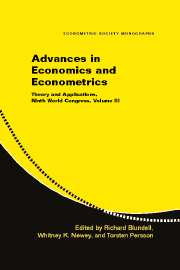Book contents
- Frontmatter
- Contents
- Contributors
- Introduction by the Editors
- 1 Identification of Nonadditive Structural Functions
- 2 Nonadditive Models with Endogenous Regressors
- 3 Heterogeneity and Microeconometrics Modeling
- 4 Heterogeneous Choice
- 5 Modeling Heterogeneity
- 6 Inference with Weak Instruments
- 7 Empirical Likelihood Methods in Econometrics: Theory and Practice
- 8 Weak Instruments and Empirical Likelihood: A Discussion of the Papers by D. W. K. Andrews, J. H. Stock, and Y. Kitamura
- 9 Estimating Continuous-Time Models with Discretely Sampled Data
- 10 Variation, Jumps, and High-Frequency Data in Financial Econometrics
- 11 Discussion of Aït-Sahalia and Barndorff-Nielsen and Shephard
- 12 Understanding Bias in Nonlinear Panel Models: Some Recent Developments
- 13 Fixed and Random Effects in Nonlinear Panel Data Model: A Discussion of a Paper by Manuel Arellano and Jinyong Hahn
- Index
- Titles in the series
9 - Estimating Continuous-Time Models with Discretely Sampled Data
Published online by Cambridge University Press: 05 January 2013
- Frontmatter
- Contents
- Contributors
- Introduction by the Editors
- 1 Identification of Nonadditive Structural Functions
- 2 Nonadditive Models with Endogenous Regressors
- 3 Heterogeneity and Microeconometrics Modeling
- 4 Heterogeneous Choice
- 5 Modeling Heterogeneity
- 6 Inference with Weak Instruments
- 7 Empirical Likelihood Methods in Econometrics: Theory and Practice
- 8 Weak Instruments and Empirical Likelihood: A Discussion of the Papers by D. W. K. Andrews, J. H. Stock, and Y. Kitamura
- 9 Estimating Continuous-Time Models with Discretely Sampled Data
- 10 Variation, Jumps, and High-Frequency Data in Financial Econometrics
- 11 Discussion of Aït-Sahalia and Barndorff-Nielsen and Shephard
- 12 Understanding Bias in Nonlinear Panel Models: Some Recent Developments
- 13 Fixed and Random Effects in Nonlinear Panel Data Model: A Discussion of a Paper by Manuel Arellano and Jinyong Hahn
- Index
- Titles in the series
Summary
INTRODUCTION
Since Merton's seminal work in the 1970s, the continuous-time paradigm has proved to be an immensely useful tool in finance and more generally economics. Continuous time models are widely used to study issues that include the decision to optimally consume, save, and invest; portfolio choice under a variety of constraints; contingent claim pricing; capital accumulation; resource extraction; game theory and more recently contract theory. The objective of this lecture is to review some of the developments in the econometric literature devoted to the estimation and testing of these models.
The unifying theme of the class of the problems I will discuss is that the data generating process is assumed to be a continuous-time process describing the evolution of state variable(s), but the process is sampled, or observed, at discrete time intervals. The issues that arise, and the problems that are of interest, at the interface between the continuous-time model and the discrete-time data are quite different from those that we typically encounter in standard time series analysis. As a result, there has been a large amount of research activity in this area.
I will start with the simplest possible model, under many assumptions that restrict its generality, and describe how different inference strategies can be developed to work under progressively richer settings, where I relax either some aspect of the model's specification and/or the manner in which the process is sampled.
- Type
- Chapter
- Information
- Advances in Economics and EconometricsTheory and Applications, Ninth World Congress, pp. 261 - 327Publisher: Cambridge University PressPrint publication year: 2007
- 4
- Cited by

